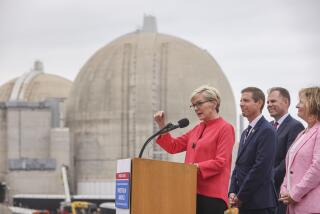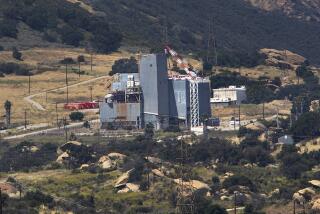Science / Medicine : 8 Finalists in Super Collider Race Grab for Political Strings
- Share via
Arizona offers sunshine and steel plants.
North Carolina promises super-computers and scholars.
New York boasts of cheap electricity and political muscle.
All eight finalists still competing for the $4.4-billion superconducting super collider offer better schools, better roads and money--lots of money--as the process for siting the huge atom-smasher moves into its second phase.
From the day it was made public, the siting process was seen by laymen and lawmakers alike as being divided into two distinct processes--the technical and the political.
The eight-state “Best Qualified List” released last week by the National Academy of Sciences and the National Academy of Engineering finished the technical process. Now the two-year process moves into the political realm of the U.S. Department of Energy.
‘You’ll . . . See Some Bargaining’
Even as Congress conducted its first set of hearings on the super collider last April, an official from what has become one of the eight finalist states matter-of-factly predicted: “Once you get to the short list, you’ll start to see some bargaining.”
That bargaining might be seen in the political power that can be exercised by large, influential state such as New York, Texas and Illinois. It will also be expected in regional coalitions, such as the efforts of North Carolina to woo support in the South and of Colorado and Arizona in seeking help in the West.
Bottom-line bargaining with offers of subsidies also is expected as states, aware of federal budget deficits and spending cuts, will offer to share costs of construction and operation of the massive science project in ways that go far beyond the minimum federal requirement of 16,000 acres of free land and 53 miles of subsurface tunnel easements.
Several states, including Colorado and Tennessee, have offered to expand or improve physics programs in their state university systems. Others, such as Texas and Michigan, promised cheap electricity to operate the 10,000 superconducting magnets at the heart of the proposed collider.
All have stressed their advantages in one of the more obscure competitive categories, living conditions for both scientists and their families.
Final Decision Is Herrington’s
Technically, the Energy Department says none of these factors will play a part in the selection process. Indeed, a recent federal law forbids it.
But none of the states still in the running are willing to withdraw any part of their offers. They believe that as the Department of Energy sets out to choose the winning site, it will be aware of federal budget constraints and is likely to consider cost-sharing offers, even if only informally.
Officially, Department of Energy documents say the eight recommended sites will be “reviewed” by a standing committee within the department called the Energy System Acquisition Advisory Board. In addition to bid papers submitted last fall--the papers used in choosing the eight finalists--this board also will look at “detailed analyses and environmental information.”
However, Energy Department guidelines make clear that Energy Secretary John S. Herrington has the ultimate responsibility for choosing the “preferred site”--the winner, pending the completion of an environmental impact statement. His decision must be based on, but not necessarily bound by, the findings of his advisory panel.
Herrington is scheduled to name the preferred site in July. The environmental review is scheduled to be completed in January, 1988, shortly before President Reagan’s term ends.
Little Hope for Reconsideration
Although much jockeying has been done by states wanting to land the scientific plum, Congress has yet to allocate any money for actual construction. The House authorized $25 million for design work in the new budget but failed to add on $10 million sought for the manufacture of the first of the super collider’s 10,000 superconducting magnets. The next budget request will be for $348 million, but analysts are already asking that the allocation be reduced to $100 million.
Meanwhile, the 17 states--including California--that failed to make first cut in the site-selection process can try to sidestep the apolitical technical evaluation by petitioning the Energy Department to reconsider their bids.
But people familiar with both the department and the collider project hold out little hope for that tactic.
“From what I can tell, the academies did a journeyman’s job--professional and thorough,” said Alvin W. Trivelpiece, executive officer of the American Assn. for the Advancement of Science and former director of the Department of Energy’s Office of Energy Research. “The likelihood of an additional state being added is very, very slim.”
COMPARISON OF FINALISTS FOR SUPER COLLIDER SITE Here, as reported in the states’ eight-volume bid packages, are some inducements offered by the eight finalists in the super collider race. Since they often deal with the uncertain costs of new construction and utility usage, the dollar value of the offers, when estimated, can cover a wide range. Some of the inducements are tangible, such as a new road or a fully endowed professorship, while others items are more ephemeral, such as quality of life. Scientists said these items were not studied in the first round of judging, but will be considered now by the Energy Department. Minimum requirements are 16,000 acres of land, good geology for tunneling, access to 250 megawatts of electrical power to run the collider, and a water supply of up to 2,200 gallons a minute.
ARIZONA
Maricopa site is 35 miles southwest of Phoenix in an area of desert plains bisected by a mountain range.
Geology quite favorable for construction using a combination of cut-and-fill and tunneling methods. Area has a strong technical and labor base. Convenient access. Housing, and employment and educational opportunities available.
Package estimated at $500 million. State fee and tax concessions. Discounted electricity. Good weather for year-round construction. Improved roads. Affordable housing. State university support.
Cost to Build: Slightly higher than average.
COLORADO
Slightly hilly topography in grasslands 60 to 70 miles northeast of Denver.
Geology is very simple and predictable. But distance to Denver and Boulder makes easy commuting and ready access to the employment, housing and cultural resources difficult. Some attention must be paid to possible vibration due to nearby oil pumping.
Package estimated at $300 million. Promise of a “cluster” of science research institutes to complement federally funded work. Improved road and railroad access to site. Rocky Mountain life style.
Cost: Slightly less than average.
ILLINOIS
Forty miles west of Chicago, directly west of the Fermi National Accelerator Laboratory in Batavia, in flat to gently rolling terrain.
Extensive tunneling experience in the area, the rock can easily be excavated. A weakness of this site would be the depth of excavation (up to 430 feet). The area is near Chicago, with all its resources, and close to an outstanding high-energy physics research lab.
Package estimated at $520 million. Additional savings of $430 million by incorporating existing facilities at Fermi National Accelerator Laboratory at the same site. Affordable housing. University fellowships.
Cost: Slightly higher than average unless Fermi lab components can be used; then “one of least costly.”
MICHIGAN
Stockbridge site, in flat farmland 35 miles from University of Michigan in Ann Arbor; Michigan State University in East Lansing.
Geology on the whole favorable; close to two major research universities. Excellent industrial base. However, several historical and archaeological sites may require attention; some roads, railroads would cross over the (collider) ring.
Package cost estimate unknown. No-strike agreement with construction workers. Low utility rates.
Cost: Very close to average.
NEW YORK
Rochester site, moderately hilly, between Rochester and Syracuse on the shore of Lake Ontario, currently 40% in forest and brush and 60% in agriculture.
Good tunneling conditions. Comparative site weaknesses include the presence of hydrogen sulfide and methane gas requiring continual ventilation. Access to several colleges and research universities. Some historical and archeological sites might need special attention.
Package cost estimate unknown. Availability of abundant, inexpensive hydroelectric power. Some potential for international cooperation and funding with Canada. Support of politically powerful coalition of New Jersey and New England states.
Cost: Slightly lower than average.
NORTH CAROLINA
Twenty miles from Research Triangle Park, in rolling, mostly forested terrain near the Virginia border.
Favorable tunneling characteristics that promise rapid excavation. Strong in local attributes that would attract and support scientific and technical staff. Access to transportation is adequate. Environmental disadvantages are generally associated with effects of urbanization on an area that is now largely forested.
Package estimated from $452 million to $537 million. Expanded physics faculty at Duke University, North Carolina State and the University of North Carolina at Chapel Hill. Proximity of Research Triangle Park technology center and proposed computing center.
Cost: Slightly below average.
TENNESSEE
Near Murfreesboro, 30 miles southeast of Nashville, in undeveloped rural land, rolling to hilly.
Favorable prospects for rapid machine excavation. Easily accessible, presence of several threatened and endangered species and presence of historic structures would require special attention.
Package cost estimate unknown. Promise of 20 new faculty jobs for particle physicists at the University of Tennessee Knoxville campus and Vanderbilt University in Nashville.
Cost: Slightly below average.
TEXAS
Dallas-Fort Worth site, in gently rolling prairie 30 miles south of Dallas.
Geology excellent. Advantages of a major urban center. Substantial acreage of prime farmland would be lost, but lease-back opportunities might diminish this. A few possible vibration sources.
Package estimated from $700 million to $1.1 billion. Sewer, road and other site improvements. Research grants for collider staff. Discount electric power. Experienced technicians on staff at the Texas Accelerator Center.
Cost: Slightly below average.
More to Read
Sign up for Essential California
The most important California stories and recommendations in your inbox every morning.
You may occasionally receive promotional content from the Los Angeles Times.












